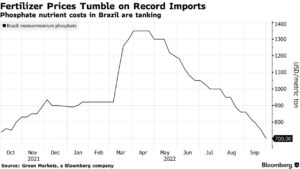Bloomberg's Leah Nylen reported Thursday that "a Colorado judge issued an order temporarily blocking the proposed $25 billion merger of Kroger Co. and Albertsons Cos., which has been challenged by…
“Most Expensive Crop in Decades,” Farmers Battling Skyrocketing Costs
Sarah Bowman, writing on the front page of the Money section in today’s USA Today, reported that, “Outside Evansville, near the corner of Indiana where it meets with Kentucky and Illinois, Randy Kron farms about 2,200 acres of corn and soybeans. By now, the corn is taller than he is, and the green vigor of the bean leaves is beginning to fade as the crop dries out.
“He’s been farming for nearly 40 years now. That means Kron remembers the farming crisis of the 1980s – a time when high interest rates sent farm debt soaring. Many families lost their farms.

“Agriculture now finds itself on the verge of crisis yet again, as farmers face growing inflation and even higher stakes. Those that produce much of the nation’s corn and soy, as well as raise its livestock, are used to battling the weather.
This growing season, however, they are also battling skyrocketing costs.
Bowman explained that, “Kron is not alone. He is one of the thousands of farmers across Indiana and the region who are up against one of their most difficult and costly years in decades.
“‘I have done this for 39 years, farming,’ he added, ‘and this is the most expensive crop in my experience.'”
Today’s article noted that, “‘Regardless of what the national inflation numbers say, it cost the farmer about 40% more to grow the crop this year’ compared to two years ago, said Chad Lee, an agronomy professor at the University of Kentucky.”
“Already tight supply chains – carried over from pandemic disruptions and extreme weather events – coupled with Russia’s invasion of Ukraine are creating a new sense of uncertainty for farmers,” today’s article said.
And Bowman added that,
While harvest is just around the corner and the growing season is nearing its end, the struggles farmers are facing may be just beginning. They worry that next year, with production costs expected to remain high, could be even worse.
Meanwhile, Bloomberg writers Tarso Veloso Ribeiro and Elizabeth Elkin reported yesterday that, “Fertilizer firms are starting to see farmers in one of the world’s biggest food suppliers pushing back on high prices for crop nutrients.
“Brazil has so much fertilizer that shipments are getting turned away. Case in point: Swiss-based fertilizer producer Ameropa AG diverted a shipment of 17,416 metric tons of monoammonium phosphate — commonly known as MAP — to the US last month due to Brazil’s full silos and dwindling demand for chemicals from farms.”

Ribeiro and Elkin pointed out that, “Brazilian farmers, who faced soaring prices for crop inputs earlier this year, are planning to cut back on fertilizer, reducing demand when supplies are ample. Such circumstances have caused fertilizer prices in the South American country to plunge.”
In a broader perspective on Brazilian fertilizer use, Constanza Valdes, an agricultural economist with the USDA’s Economic Research Service, indicated in a recent Amber Waves article that, “In 2021, Brazil’s fertilizer use accounted for 17.3 percent of total world fertilizer consumption. Brazil is the world’s fourth-largest fertilizer importer, behind China, India, and the United States. More than 70 percent of fertilizer in Brazil goes to three crops: soybeans (44 percent), corn (17 percent), and sugarcane (11 percent). Fertilizer costs account for 25 percent of operating costs for soybeans in the traditional southern agricultural region, 21 percent for wheat and corn in the western frontier region, and 12 percent for sugarcane in both regions. Because about 85 percent of the fertilizer consumed in Brazil is imported, changes in oil prices directly affect the price farmers pay for fertilizer. Disruptions to fertilizer imports, made more profound by the Black Sea conflict given that Russia and Belarus combined provide almost 40 percent of its needs, and higher prices are expected to reduce the amount of fertilizer Brazilian farmers apply to their fields. That would contribute to lower crop yields and reduced expansion of area planted to crops. A decrease in feed grain production because of reduced use of fertilizer would affect Brazil’s livestock sector, especially poultry and swine.”
And Bloomberg writer Jen Skerritt reported yesterday that, “The world sorely needs more grains, and Canada has a bin-busting harvest this year. Unfortunately, there aren’t enough rail cars to transport it all.
“There were almost 2,400 outstanding grain-car orders for the nation’s two major carriers, Canadian National Railway Co. and Canadian Pacific Railway Ltd. in the latest data from Ag Transport Coalition.”
Skerritt added that, “Shippers are worried about the railways’ ability to haul grain as Canadian farmers are harvesting the nation’s third biggest wheat crop on record and 42% more canola than a year ago. Canadian Pacific has fallen behind orders for three weeks and grain companies will have to defer sales if the trend continues, [Wade Sobkowich, the executive director of the Winnipeg-based Western Grain Elevator Association] said.”





